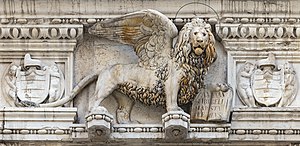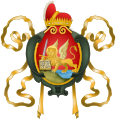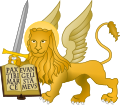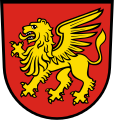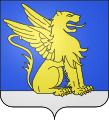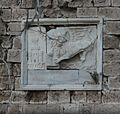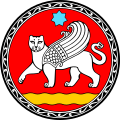
Mark the Evangelist also known as John Mark or Saint Mark, is the person who is traditionally ascribed to be the author of the Gospel of Mark. Modern Bible scholars have concluded that the Gospel of Mark was written by an anonymous author rather than an identifiable historical figure. According to Church tradition, Mark founded the episcopal see of Alexandria, which was one of the five most important sees of early Christianity. His feast day is celebrated on April 25, and his symbol is the winged lion.

Piazza San Marco, often known in English as St Mark's Square, is the principal public square of Venice, Italy, where it is generally known just as la Piazza. Almost all the other urban spaces in the city are called campi ("fields"). The Piazzetta is an extension of the Piazza towards San Marco basin in its southeast corner. The two spaces together form the social, religious and political centre of Venice and are referred to together. This article relates to both of them.

The Patriarchal Cathedral Basilica of Saint Mark, commonly known as St Mark's Basilica, is the cathedral church of the Patriarchate of Venice; it became the episcopal seat of the Patriarch of Venice in 1807, replacing the earlier cathedral of San Pietro di Castello. It is dedicated to and holds the relics of Saint Mark the Evangelist, the patron saint of the city.
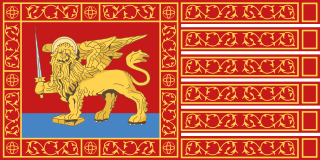
The Republic of Venice or Venetian Republic, traditionally known as La Serenissima, was a sovereign state and maritime republic in parts of the present-day Italian Republic, Istria and Dalmatia that existed for 1,100 years from 697 until 1797. Centered on the lagoon communities of the prosperous city of Venice, it incorporated numerous overseas possessions in modern Croatia, Slovenia, Montenegro, Greece, Albania and Cyprus. The republic grew into a trading power during the Middle Ages and strengthened this position during the Renaissance. Most citizens spoke the Venetian language, although publishing in Italian became the norm during the Renaissance.

The Italian Navy is the navy of the Italian Republic. It is one of the four branches of Italian Armed Forces and was formed in 1946 from what remained of the Regia Marina after World War II. As of August 2014, the Italian Navy had a strength of 30,923 active personnel, with approximately 184 vessels in service, including minor auxiliary vessels. It is considered a multiregional and a blue-water navy.

Agostino Barbarigo was Doge of Venice from 1486 until his death in 1501.

The lion is a common charge in heraldry. It traditionally symbolises courage, nobility, royalty, strength, stateliness and valour, because historically the lion has been regarded as the "king of beasts". The lion also carries Judeo-Christian symbolism. The Lion of Judah stands in the coat of arms of Jerusalem. Similar-looking lions can be found elsewhere, such as in the coat of arms of the Swedish royal House of Bjelbo, from there in turn derived into the coat of arms of Finland, formerly belonging to Sweden.

San Francesco della Vigna is a Roman Catholic church in the Sestiere of Castello in Venice, northern Italy.

The winged lion is a mythological creature that resembles a lion with bird-like wings.
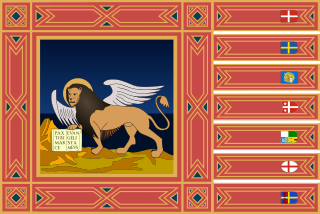
The flag of the Italian region of Veneto derives from the flag historically used by the Republic of Venice (697–1797), a maritime republic centered on the modern city of Venice. The modern flag was adopted by legge regionale20 maggio 1975, n. 56 and amended by L.R. del 22 febbraio 1999, which deleted the words "Regione del Veneto". Regione del Veneto also has a banner (gonfalone), its design identical to the flag's except in its vertical orientation.

Britain's Secret Treasures is a British documentary shown on ITV hosted by Michael Buerk and Bettany Hughes. The programme features fifty archaeological discoveries that have been made in England, Wales and Scotland by members of the public. With the exception of a single find made in Scotland, all the objects featured were recorded by the Portable Antiquities Scheme (PAS). Since the PAS was set up in 1997, some 800,000 objects have been registered with the scheme, many of them discovered by amateur metal detectorists.

The Lion of Venice is an ancient bronze sculpture of a winged lion in the Piazza San Marco of Venice, Italy, which came to symbolize the city – as well as one of its patron saints, St Mark – after its arrival there in the 12th century. The sculpture surmounts one of two large granite columns in the Square, thought to have been erected between 1172 and 1177 during the reign of Doge Sebastiano Ziani or about 1268, bearing ancient symbols of the two patron saints of Venice.
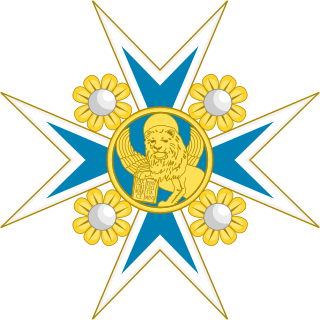
The Order of Saint Mark was the sole order of chivalry of the Republic of Venice. It was named in honour of Venice's patron saint, Mark the Evangelist.

The Generali Building is a landmark office and commercial building on Jaffa Road in West Jerusalem. Designed by Marcello Piacentini, chief architect of the Italian Fascist regime, it served as the Jerusalem branch of the Assicurazioni Generali insurance company from 1935 to 1946. In 1946 the British Mandatory government nationalized the building and enclosed it and several other structures at the eastern end of Jaffa Road in a fortified security zone. With the end of the Mandatory government in 1948, the building was taken by the Irgun. Since the establishment of the state, the Generali Building has housed the offices of the Jerusalem District Administration and other government agencies, and street-level stores. The building's neoclassical and modern architecture, and large, rooftop sculpture of a Lion of Saint Mark have made it a prominent landmark in downtown Jerusalem.

The Regatta of the Historical Maritime Republics is a sporting event of historical re-enactment, established in 1955 with the aim of recalling the rivalry of the most famous Italian maritime republics: those of Republic of Amalfi, Republic of Pisa, Republic of Genoa and Republic of Venice, during which four rowing crews representing each of the republics compete against each other. This event, held under the patronage of the President of the Italian Republic, takes place every year on a day between the end of May and the beginning of July, and is hosted in rotation between these cities. The regatta is preceded by a historical procession, during which parade through the streets of the city organizing some figures that play the role of ancient characters that characterized each republic.

The Flag of the Republic of Venice, commonly known as the Banner or Standard of Saint Mark, was the symbol of the Republic of Venice, until its dissolution in 1797.
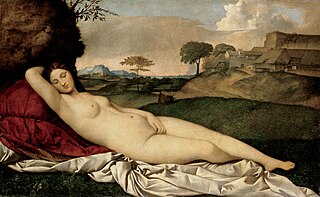
The Venetian Renaissance had a distinct character compared to the general Italian Renaissance elsewhere. The Republic of Venice was topographically distinct from the rest of the city-states of Renaissance Italy as a result of their geographic location, which isolated the city politically, economically and culturally, allowing the city the leisure to pursue the pleasures of art. The influence of Venetian art did not cease at the end of the Renaissance period. Its practices persisted through the works of art critics and artists proliferating its prominence around Europe to the 19th century.
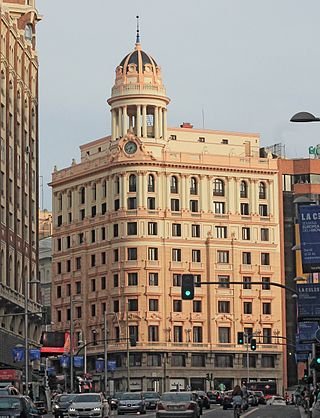
The Edificio La Adriatica is a building at Plaza del Callao 3 and Gran Vía 39 in Madrid.

Saint Mark's relics, the remains of Mark the Evangelist, are held in St Mark's Basilica in Venice, Italy.

The Monument to Victor Emmanuel II, known by the Venetians simply as the monument, located in Riva degli Schiavoni, in Castello, Venice, Italy. It is an equestrian statue made in 1887 by the Roman sculptor Ettore Ferrari.
